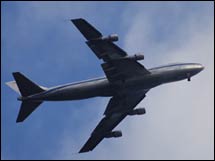|
Airlines still in upheaval, 5 years after 9/11 Experts say 9/11 only sped up significant changes that were bound to shake airlines even without the attack. NEW YORK (CNNMoney.com) -- Five years after the Sept. 11 terrorist attack, the nation's airline industry is still struggling to regain altitude, even as U.S. passengers are flying more than ever before. What's not quite as clear is how much the changes that have shaken the major airlines since 2001 are due to 9/11, and how many would have been seen anyway due to broader economic and competitive issues totally separate from the attack.
Most experts believe that there is little lingering impact on Americans' willingness to fly today due to the attack, even if the risk of terrorism is still a major concern for much of the population. In fact, a record 738 million airline passengers flew in 2005, up 10 percent from the previous record set in 2000. The first seven months of this year have seen 324 million passengers, off only 1.5 percent from the year-ago pace, and miles flown is actually up a bit. But experts say the shock of 9/11 spurred the industry, particularly the older "legacy" carriers, to jump start a series of changes that are still in the process of taking place. The cuts in their cost structure and labor costs would have been needed even without the attack. "It put their feet to the fire, and forced them to make changes they would have had to have made anyway," said Ray Neidl, airline analyst for Calyon Securities. "I don't know if they would have made such drastic changes (without the attack). Sept. 11 speeded up the process." The legacy carriers - American Airlines (Charts), Delta Air Lines (Charts), United (Charts), Continental (Charts), Northwest (Charts) and US Airways (Charts), had to face new lower-cost competitors entering their markets, and all airlines had to face soaring fuel prices over the last five years. Besides the new security procedures instituted after the attack, the changes in the industry have meant that air passengers are seeing more choices and lower fares on many routes. "The legacy carriers were forced to pull back their capacity, and that opened a vacuum that the low-cost carriers could fill," said Phil Baggaley, the senior airlines credit analyst for rating agency Standard & Poor's. "I think 9/11 made a material difference in that way -- it accelerated a trend that was already occurring." Partly due to the growth of those lower-fare carriers, fares, as measured by the average amount paid per mile by passengers, still haven't returned to pre-attack levels, even though some key costs, particularly fuel, are much higher for the airlines. But the change in economics also means much fuller planes for passengers, as the airline industry has controlled capacity in a way never seen before, and filled a record percentage of seats this past summer. Five years of steep losses No one would argue that the airline industry as a whole is financially weaker after $42 billion in collective losses from 2001 through 2005. The legacy carriers at least find themselves with a more competitive cost structure today than they did on Sept. 10, 2001. But that doesn't mean they are better off. They're weaker financially," said S&P's Baggaley. "They've put all their assets into hock." Two of the largest carriers -- Delta and Northwest -- are operating under bankruptcy protection, and two others -- United Airlines and US Airways, have flown in and out of bankruptcy court, with US Air making the trip twice before it was purchased by a smaller rival. But this past summer the industry was able to return to making money, even though jet fuel, now its largest cost, is up 168 percent from pre-attack levels. John Weber, a vice president with airline consultant and research firm Back Aviation, said he doesn't believe Sept. 11 did anything but maybe jump start changes that the airlines would have made anyway during the last five years. "It's the economy that drives the aviation business, not any single accident or terrorist event," he said. "It was more the bursting of the Internet bubble than anything else that drove (the airline industry) into the downturn the first half of the decade. The fact 9/11 happened was a mere coincidence." But another airline consultant, Michael Boyd, said that he believes airlines, particularly the old-line carriers, underwent a fundamental change due to 9/11, even if other economic factors such as fuel and new competitors were more important than the attack itself. "The shock of 9/11 and the aftermath of it, was the instrument that fundamentally changed the industry," he said. "Airlines finally realized they couldn't support the costs they had before." The six major legacy carriers responded to the attack by announcing about 100,000 job cuts within a month of the attack, and by grounding their older, less fuel efficient planes. Those cuts continued even as the attacks faded into memory. John Heimlich, chief economist for the Air Transport Association, the industry trade group, says that the six legacy carriers have reduced their employment by 38 percent since before the attacks, or the equivalent of 169,000 full-time jobs, as they trimmed their fleets by more than 800 planes, or about 23 percent. The rest of the industry, including low-cost and regional carriers, have seen a net increase of only about 14,000. Heimlich, speaking in the week before the fifth anniversary, said that even though the trends in the industry were all pushing for changes before the attack, there is no doubt the industry's fundamental finances were changed as a result of Sept. 11. "My strong feeling is that the magnitude, scope and pace of the changes were all much greater than would have been otherwise," he said. |
|


